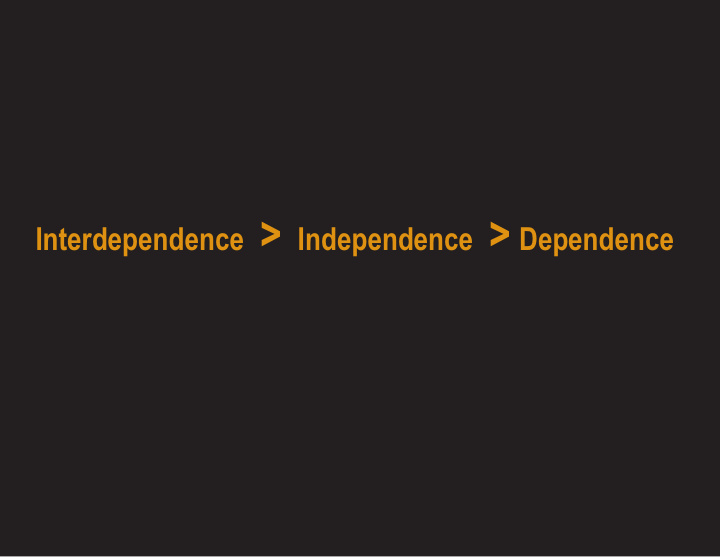



Interdependence > Independence > Dependence
Supply Chain and Management of the Improvement Process in SME (Small & Medium Enterprise) An updated approach to understand the dynamics of the value chains Lecturer: M.Sc. Javier Cruz Morales Consultant in Business Management and the Change Process The Goal: “To acknowledge and analyze the necessary change process in your organization, starting on your actual level of competitiveness, by means of the research on better practices of strategic administration, a better market approach and the development of more efficient business models”.
Interdependence > Independence > Dependence In business management, interdependence stems from the generation of better business relations.
Business Relationships in Supply Chain 1 They are Proactive 2 They happen in a win-win context 3 A change of paradigms is involved 4 A preparation process is required 5 Continuous improvement is required
Business relationships in the value chain are: • As dependent as the most dependent • As fast as the slowest • As safe as the least safe
What problems does the Supplier Chain Administration solve in your company? Lack of precision in the prognosis of the demand? It is not necessary to administer the risks of the supplier The purchase administration is divided in different areas in the company Opportunity areas of Supply The authority line is not clear Chain Management Incomplete information on the • Competitive prices (productivity inventory and features of cost reduction) • Delivery time * Lack of leadership and management • Quality The people responsible for the • Technical Support chain of strategic changes are non- existent • Customer Service * Others
The more common handicaps found in Benefits of being part of a PL failed relationships (Productive Linkage) process • Individualism • To enter in the context of systemic competitiveness • Only competence relationships • Strategy in the long term • Distrustfulness • Competitive advantages that would not be obtained • Short term thinking individually • Different approaches on the strategy • Generation of AV for the individual and the group • Heterogeneity of the group • Trust relationships and decrease of transaction costs • Cost & Time Coordination • Flexibility in the market approach • Information costs • Access to infrastructure • Unfulfilled expectations • Access to technology (transfer, R+D, etc.) • Conflict of interests (specially regarding on results • Access to financing distribution) • Access to a more appropriate training • Businessmen despair easily if they do not achieve immediate results.
Organizational environment Transparency Innovation Support Leadership Influence Communication Strategy HR Administration Main Problem to achieve Improvement the consolidation of this Management kind of relationships:
The Influences of the Environment + The Dynamics of change Do the dynamics of the market in the sector/category we are part of, or do they not generate opportunities in a certain environment?
The Business Environment is characterized by the new paradigms that are in force: e-business Efficiency The age of e-learning Certification information e-data Service e-commerce Results e-money Relationships
� � How do I make Money in my trade?
Main purpose: To identify and take advantage of joint opportunities: Manufacturing Raw Materials Warehousing Distribution Points Retailers Logistics • To halve business cycles Consumer • To identify the restrictions of the mentioned above • To know the demand of the used capital • To identify the process of added value • To assess the installed capacity • To identify the equipment demand • To know the information currents • To set the performance markers • To measure the net operational efficiency of the assets
Methodology to increase Metodología para mejorar la competitiveness competitividad
What does the manager do? 1. The manager sets the objectives 2. The manager organizes 3. The manager motivates and communicates 4. The manager measures and controls 5. The manager promotes development in people and even in himself:
The Improvement Process I.To create a context to change... II.To promote commitment... III To balance innovation and stability...
Results The Strategic Context and Strategy Making Unabridged definitions Decisions 1. Plan 4 4 2. Behavior pattern 3. Position 4. Perspective
Recommend
More recommend